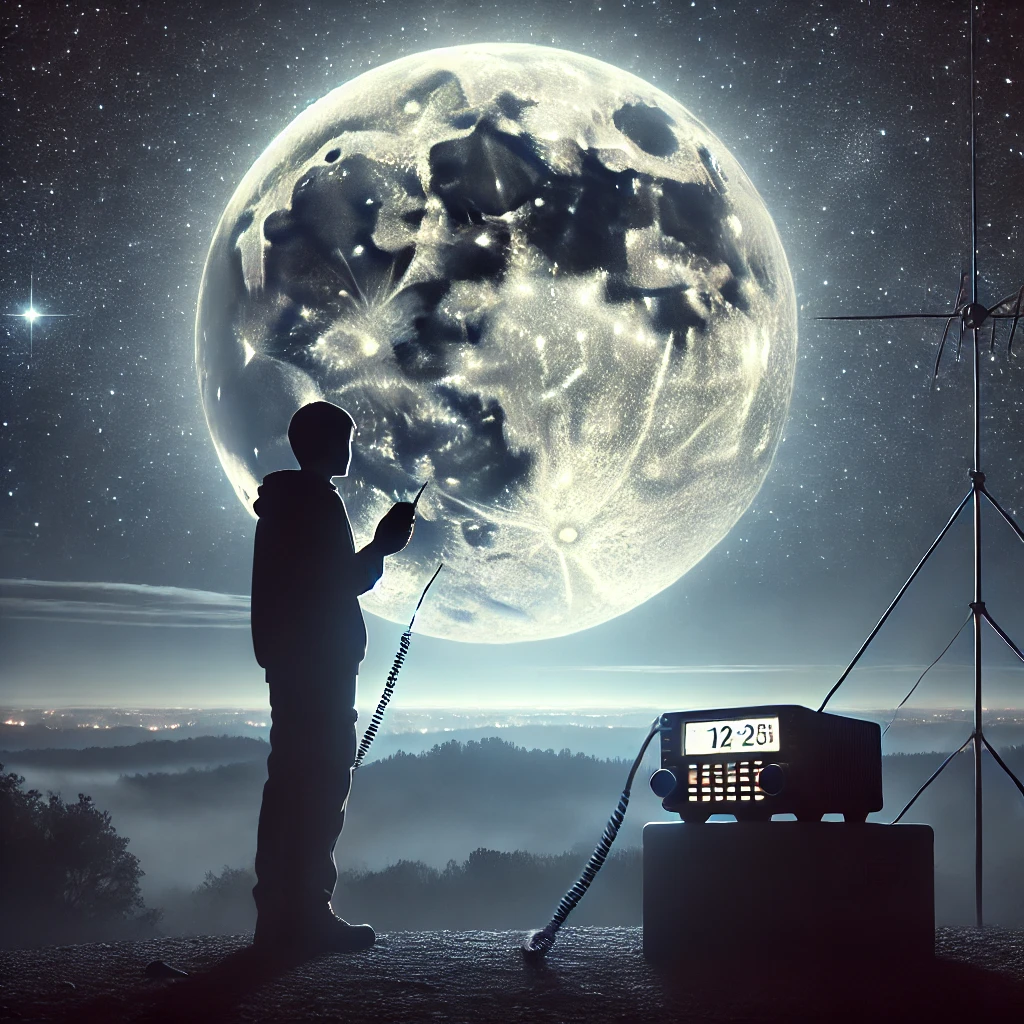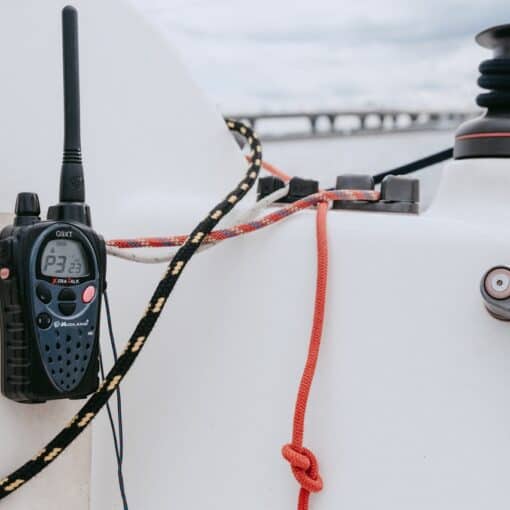Ham radio moon bounce, or Earth-Moon-Earth (EME) communication, is a fascinating technique. It allows enthusiasts to send radio signals by using the Moon as a reflective surface. This unique method makes it possible for operators to connect with others across great distances by bouncing signals off the Moon’s surface. Many amateurs see this as a pinnacle of skill and technology in the world of radio communications.

Getting started with ham radio moon bounce requires understanding its technical aspects and equipment needs. Operators must learn how to set up their stations effectively. They also need to familiarize themselves with the specific frequencies and modes used for EME communication. The challenges of this practice can be significant, but the rewards are equally impressive, as it connects people and fosters a vibrant community of enthusiasts.
In addition to the technical skills required, there are numerous resources available for those interested in ham radio moon bounce. Online forums, groups, and specialized websites provide a wealth of information for both beginners and experienced operators. This ongoing support not only enhances individual skills but also strengthens the ham radio community as a whole.
Key Takeaways
- EME communication uses the Moon to bounce signals for long-distance contact.
- Understanding equipment and operational techniques is crucial for success.
- The ham radio community offers valuable resources for learning and collaboration.
Understanding Ham Radio Moon Bounce

Ham radio moon bounce, also known as Earth-Moon-Earth (EME) communication, involves transmitting radio signals to the Moon and having them reflected back to Earth. This technique allows amateur radio operators to connect over long distances using the Moon as a natural satellite reflector.
What Is Moon Bounce?
Moon bounce refers to the process of sending radio signals from one location on Earth to the Moon and back to another location on Earth. This communication method uses the Moon’s surface as a reflector, making it possible for signals to travel great distances.
Operators typically use specialized equipment and techniques. They often work with low frequencies and may utilize narrowband digital modes like Q65 and JT65B. These modes allow for clearer communication, even with modest setups. Successful EME operation requires careful planning of equipment, antenna orientation, and timing.
History and Significance of EME
The idea of bouncing signals off the Moon dates back to the early 1960s. This method became notable during the Apollo missions when scientists demonstrated its feasibility. Amateur radio operators quickly adopted EME as a means of long-distance communication.
The significance of EME lies in its ability to connect enthusiasts globally, even with limited resources. It allows for unique challenges, including ionospheric disturbances that can affect radio waves. As technology has advanced, so has EME communication, making it accessible to more operators. This technique fosters collaboration and innovation within the ham radio community.
Technical Aspects of EME Communication
EME communication, or Moonbounce, involves several technical elements that are crucial for successful operation. This section details essential concepts, signal characteristics, equipment requirements, and noise considerations that ham radio operators must understand to effectively engage in EME.
Key Concepts in EME
EME communication uses the Moon as a reflector for radio signals. The setup requires knowledge of the Earth-Moon-Earth (EME) propagation method. It is vital for operators to understand the delay caused by the distance between Earth and the Moon. It takes about 2.5 seconds for a radio signal to travel to the Moon and back.
Effective communication also demands consideration of the Moon’s position and phase. Operators must track its changing position to maximize their chances of successful contacts.
Radio Signals and Frequencies
Radio signals for EME typically operate in VHF and UHF bands. The most common frequencies used include 144 MHz, 432 MHz, and 1296 MHz. These frequencies are chosen for their ability to provide clearer paths for the signals.
Each band has unique characteristics. The 144 MHz band is widely used but may have more competition. The 432 MHz band offers better performance with lower noise, and 1296 MHz can deliver significant gains if operators utilize the right equipment.
Antennas and Polarization
Antennas are critical for EME success. Yagi antennas are popular due to their directional capabilities and gain. Operators often use multiple Yagi antennas combined for better performance.
Polarization also plays a vital role. Circular polarization can help in minimizing signal loss caused by reflections. Properly configured antennas can significantly enhance signal strength and quality during the communication.
Transceivers and Power Amplifiers
When it comes to equipment, transceivers must be robust enough for EME communication. They should support the necessary frequency bands and have features for efficient signal processing.
Power amplifiers are crucial as well. They increase the output power of the transmission, allowing for better signal reach. Many operators use high-quality low noise amplifiers to reduce interference and improve clarity.
Noise Considerations in EME
Noise is a significant challenge in EME communication. It can come from various sources, including atmospheric conditions and electronic devices. Operators must use sensitive equipment that can filter out unwanted noise.
Implementing good grounding techniques and using noise-reducing filters can help minimize these issues. Careful planning and technical knowledge are needed to ensure successful reception of signals over the vast distance to the Moon.
Operational Techniques for EME
To successfully engage in Earth-Moon-Earth (EME) communication, operators must understand various operational techniques. This includes setting up equipment correctly, using digital modes for effective signal transmission, and grasping the complexities of Doppler shift and timing for better contacts.
Setting Up for First EME Contacts
When preparing for EME contacts, the setup is crucial. Operators should start by selecting a suitable antenna. Common choices include parabolic dishes or Yagi antennas for their ability to focus signals.
Next, ensure the transceiver is capable of operating on the desired frequencies, typically in the 144 MHz or 432 MHz bands. A clean and clear RF environment is essential to minimize interference.
Operators often use high power levels of around 100-400 watts to boost weak signals bouncing off the moon. It’s also essential to choose an appropriate mode, such as JT65 or FT8, which can enhance decoding capabilities for weaker signals.
Using Digital Modes and Software
Digital modes are pivotal for EME operation, particularly when dealing with weak signals. JT65 and FT8 are popular choices due to their robustness in low signal-to-noise ratios.
Software like WSJT or WSJT-X simplifies the process of transmitting and decoding signals. These programs generate decodable messages that can effectively communicate contacts even when signals are faint.
Operators must familiarize themselves with the software features. This includes setting the correct frequency offset and ensuring transmission timing aligns with the moon’s position to optimize the chance of making successful QSOs.
Understanding Doppler Shift and Timing
Doppler shift affects frequency during EME communication. As the moon orbits, the relative movement causes a measurable shift in frequency. Operators need to adjust their frequency settings to account for this shift.
Timing is also crucial. Each transmission should be timed accurately to align with moon phases and optimal conditions.
Correctly managing these aspects allows for clearer communication. It can significantly improve the chances of connecting with other operators, especially during the initial attempts at EME contacts. Knowledge of Doppler effects and precise timing ultimately leads to more successful EME operations.
Modes of EME Communication
EME communication employs various modes to enhance signal transmission to and from the Moon. Each mode has its own strengths and is suited for different conditions. Below are the key modes utilized in EME communication.
CW (Continuous Wave) Mode
CW, or Continuous Wave, is a classic method used for EME communications. This mode transmits Morse code signals, which are simple to generate and decode.
Operators often choose CW due to its effectiveness in overcoming noise and interference. The narrow bandwidth helps to minimize the impact of fading signals.
With CW, users can achieve reliable communications even during poor conditions. Many experienced operators prefer this method for long-distance communication due to its simplicity and effectiveness.
SSB (Single Sideband) Mode
Single Sideband (SSB) is a more advanced voice transmission mode used in EME operation. Unlike FM or AM, SSB modulates audio signals into a higher frequency range.
This method allows for clearer voice communication over the EME path. SSB is efficient in terms of bandwidth, making it suitable for crowded frequencies.
Operators can enjoy better audio quality and reduced static with SSB. This is especially useful for real-time conversations. With proper equipment, it can achieve effective communications even during challenging conditions.
Digital and Weak-Signal Modes
Digital modes are becoming increasingly popular for EME communication due to their resilience against noise. Some common digital modes include Q65, FT8, and JT65.
- Q65: This mode is designed for weak-signal environments and allows for quick exchanges.
- FT8: Known for its ability to work with very weak signals, FT8 is a favorite among many ham radio operators.
- JT65/JT65B: These modes are also effective for EME, allowing for low power operations while achieving successful contacts.
Digital modes utilize automation to facilitate exchanges. This reduces the operator’s workload and increases efficiency. These modes are especially advantageous for those who operate low-power stations.
Challenges and Advancements
Ham radio moon bounce, or EME (Earth-Moon-Earth) communication, faces several technical challenges and has seen notable advancements. These factors greatly influence operators’ ability to communicate effectively using this unique method.
Overcoming Technical Obstacles
EME communication presents specific challenges, particularly with weak signals and the need for a clear line of sight to the Moon. Signal loss can occur over long distances, making it harder to establish a reliable connection. Operators must ensure their equipment is properly set up.
Using high-quality coaxial cable is crucial to minimize loss during transmission. Furthermore, careful planning of the environment, including consideration of grid squares, can improve operational success. The VUCC (VHF/UHF Century Club) program encourages the use of grid squares for logging and recognition. As operators navigate these obstacles, serious attention needs to be given to antenna selection and positioning.
Innovations in EME Technology
Innovations in technology have enhanced EME communication capabilities. Recent advancements have improved signal processing, allowing operators to handle weak signals much more effectively. Tools and software such as mmmonvhf.de provide real-time data for signal reporting and tracking, which helps in optimizing communications.
Newer antennas designed for EME are more sensitive and better at picking up faint signals. This helps operators achieve successful contacts even under challenging conditions. Digital modes like FT8 and reduced bandwidth techniques enable clearer communication despite signal difficulties. Operators can now connect with more stations across long distances thanks to these ongoing technological improvements.
Community and Resources
The ham radio community offers a wealth of support for those interested in EME (Earth-Moon-Earth) communication. This section covers the key groups and resources available to enhance the moon bounce experience and improve knowledge.
Amateur Radio Operator Community
The amateur radio operator community is vibrant and welcoming. Enthusiasts come from various backgrounds but share a passion for radio communications. Many local clubs exist, where members meet to discuss techniques, share equipment, and organize events.
Bouncing signals off the Moon, or moon bounce, is often a hot topic. Experienced operators can offer tips on antenna setups and equipment choices for EME communication. Networking with fellow radio hams fosters collaboration, leading to shared successes in making contact via moon bounce. Online platforms, like forums and social media groups, also facilitate discussions.
Websites and Learning Materials
Numerous online resources cater specifically to moon bounce and EME communication. Websites such as hamradio.engineering provide detailed articles and technical insights into setting up a successful EME station.
Other sites offer tutorials on equipment and techniques for effective signal transmission. Learning materials also include books and manuals focused on amateur radio.
These resources often cover essential topics like antenna design and propagation methods. Additionally, radio hams can find multimedia content, such as instructional videos, that simplifies complex concepts.
Exploring these resources can drastically improve a radio operator’s skills and understanding.
Joining EME Events and Contests
Participating in EME events and contests is a practical way to gain experience. Many organizations host regular contests aimed at encouraging moon bounce activity.
These events provide opportunities for operators to practice their skills, enhance their setup, and connect with others. Operators can also find information about EME activities on websites like mmmonvhf.de.
This site tracks events, propagation conditions, and new technologies related to amateur radio. Joining these contests fosters camaraderie among radio hams while helping them stay motivated and engaged in their hobby.
Frequently Asked Questions
This section addresses common inquiries regarding Earth-Moon-Earth (EME) communication in ham radio. Each question focuses on essential equipment, signal propagation, frequencies, technical challenges, and the communication process.
What equipment is needed for Earth-Moon-Earth (EME) communication?
To engage in EME communication, one typically requires a high-gain antenna, an efficient transmitter, and a sensitive receiver. Common antenna types include parabolic dishes or Yagi antennas, which help focus the signal toward the Moon.
How does the propagation time affect radio signals bouncing off the Moon?
The signal’s propagation time for a round trip to the Moon is about 2.5 seconds. This delay can impact the timing of transmissions and responses in a conversation, requiring operators to plan their exchanges accordingly.
What are the most commonly used frequencies for moon bounce communications?
The most active frequencies for moon bounce communication are mainly in the VHF and UHF bands, particularly 144 MHz and 432 MHz. Operators may also use microwave bands like 1296 MHz and higher for EME.
What are the technical challenges of setting up an EME antenna for amateur radio?
Setting up an EME antenna poses several challenges. Operators need to ensure sufficient gain and proper elevation to point at the Moon. They also need to consider factors like wind load and sturdy mounting solutions to maintain the antenna’s position.
What is the process involved in establishing moon bounce communication for beginners?
Beginners should start by selecting appropriate equipment and learning about EME techniques. They can then aim their antenna at the Moon and transmit signals while listening for echoes to confirm communication. Building skills through practice is essential.
How are moon bounce signals decoded and understood in amateur radio practices?
Moon bounce signals are often decoded using digital modes like JT65 or Q65. These modes help to demodulate weak signals. They also provide a clearer exchange, making communication more effective even at low power levels.





